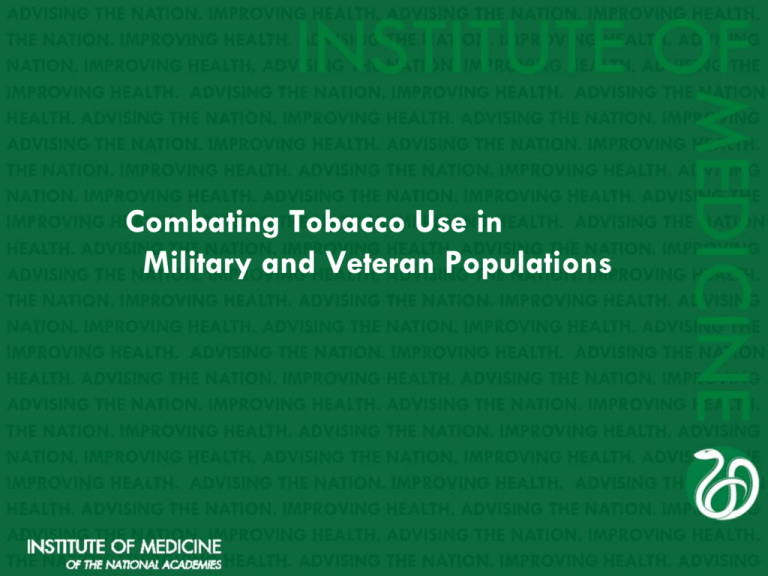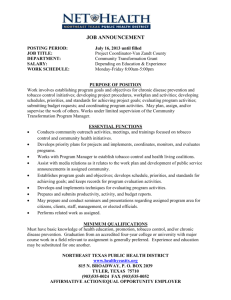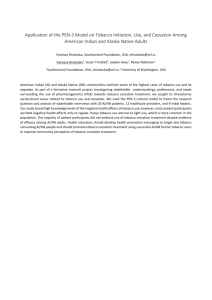Power Point Presentation
advertisement

Combating Tobacco Use in Military and Veteran Populations Committee on Smoking Cessation in Military and Veteran Populations • • • • • • • • • • • • • • • STUART BONDURANT, MD (Chair), University of North Carolina at Chapel Hill NEAL L. BENOWITZ, MD, University of California, San Francisco SUSAN J. CURRY, PhD, University of Iowa ELLEN R. GRITZ, PhD, University of Texas and M.D. Anderson Cancer Center PETER D. JACOBSON, JD, MPH, University of Michigan School of Public Health KENNETH W. KIZER, MD, MPH, Medsphere Systems Corporation ROBERT C. KLESGES, PhD, University of Tennessee Health Science Center/St. Jude Children's Research Hospital HOWARD K. KOH, MD, MPH, Harvard School of Public Health (resigned March 25, 2009) WENDY K. MARINER, JD, LLM, MPH, Boston University School of Public Health/School of Law ANA P. MARTINEZ-DONATE, PhD, University of Wisconsin–Madison ELLEN R. MEARA, PhD, Harvard Medical School ALAN L. PETERSON, PhD, University of Texas Health Science Center at San Antonio FRANCES STILLMAN, EdD, Johns Hopkins Bloomberg School of Public Health EDWARD P. WYATT, EWyatt Consulting, LLC DOUGLAS M. ZIEDONIS, MD, MPH, University of Massachusetts Medical School Committee’s Charge Identify ways in which the DoD and the VA can work together to improve the health of both active duty and veteran populations with regard to smoking initiation and cessation. Specifically: • Identify policies and practices that might beused by the DoD and the VA to prevent initiation of smoking and tobacco use in the military. • Identify policies or potential barriers that might inhibit broader implementation of evidence-based tobacco use cessation care within both DOD and VA. • Identify opportunities for increased access to evidence-based smoking and tobacco use cessation programs within VA and DOD. • Evaluate changes, including changes in policy, that could help lower smoking and tobacco use rates in military and veteran populations. • Identify policies and practices that address unique tobacco use prevention and cessation needs of special populations in DOD and VA, including populations such as those with psychiatric or other substance use disorders, populations with chronic medical comorbidities, women, and others. • Recommend research approaches for reducing initiation of tobacco use and promoting tobacco use cessation. Committee’s Approach • 2 public sessions to hear from VA and DoD representatives, including Army, Navy and Air Force • Reviewed publicly available VA and DoD documents and published literature • Requested information from VA and DoD contacts • Reviewed state of the art tobacco programs Scope of the Problem • Over 32% of military personnel and 22% of veterans smoke and 15% of military personnel use smokeless tobacco. • Tobacco use impairs military readiness • Short-term health effects • Long-term health effects • Involuntary exposure to secondhand smoke Factors that Influence the Use of Tobacco • Individual (genetic makeup, age, sex, psychological/behavioral status) • Interpersonal (family, colleagues, friends) • Community (work environment, educational and recreational environment) • Societal (government, industry, media) • Overarching factors include tobacco product availability and cost Goal: Tobacco-free populations • In the short-term: – Reduced tobacco use initiation – Increased tobacco use cessation • In the long-term – Have tobacco-free VA facilities – Achieve the DoD and Armed Services stated goal of being tobacco-free Comprehensive Tobacco-Control Programs • Program Components – Strategic Plan (evidence-based and adapted to local circumstances and population) – Engaged leadership – Effective and enforceable policies – Communication interventions – Therapeutic interventions – Surveillance – Evaluation – Management capacity to effect change in response to evaluation VA already has some components in place • • • • • • • An operating comprehensive health-care organization Smoke-free facilities policy Communication opportunities Tobacco cessation interventions without copay Some trained tobacco-cessation health-care providers Surveillance tools Periodic program evaluations DoD also already has many program components in place • A strong operating, comprehensive health care organization • Tobacco Use Prevention Strategic Plan developed in 1999 • Many tobacco restrictions in place • New communication tool, “Quit Tobacco. Make Everyone Proud” • Tobacco-cessation interventions But….. • VA cannot go entirely smoke-free because of legislative requirements • VA programs are not consistent or coordinated • Tobacco cessation has not received highly visible support from senior leadership • Lack of information on program effectiveness: what is really working for veterans? And…. • DoD continues to sell tobacco at a discount • Tobacco is perceived by many as part of military culture • Rules and regulations on the books are not consistently enforced • Tobacco use is still permitted on installations albeit in designated areas Some Barriers to Care for Veterans • Cannot attend counseling sessions when offered • Difficult to get a prescription for tobacco-cessation medications • Spouse cannot participate in VA tobaccocessation program • Cannot immediately access tobacco-cessation intervention when motivated to quit so opportunity may be lost • Lack of concurrent treatment for tobacco use and mental health disorder Institutional Barriers in VA • Requirement for smoking shelters at medical care facilities • Lack of sufficient staff trained in tobacco-cessation interventions (including mental health providers) • Lack of prescribing privileges for tobacco-cessation medications among health-care providers • No documentation effectiveness of tobacco cessation interventions • Lack of forceful advocacy for tobacco control and promotion of the most effective tobacco cessation tools Barriers to Care for Military Personnel • Counseling not offered at convenient times • Need to coordinate two sources for tobacco-cessation treatment: medical staff for medications and health promotion staff for counseling • Senior staff and role models who use tobacco • Perception that tobacco use is acceptable • Used to relieve stress and boredom of deployment Institutional Barriers in DoD • Congressional and tobacco industry influence • Tobacco control not perceived as a high priority for DoD leadership • Tobacco use is not considered to impact readiness • Discounted price of tobacco products Overcoming Barriers in VA • National quitline to reach more veterans • Train all health care providers in tobacco cessation • Consider including spouses in tobacco-cessation programs • Close smoking shelters at VA facilities Overcoming Barriers in DoD • National DoD quitline • Train all health promotion/health care personnel to provide tobacco cessation interventions • Eliminate sale of tobacco products on military installations • Eliminate designated tobacco-use areas • Establish tobacco use as a military readiness and safety issue • Treat smokeless tobacco as equal to smoked tobacco Bottom line: • Set a timeline for all services to be tobacco-free • Close the pipeline of tobacco users entering the military using a phased approach • Ban tobacco use during technical/advanced training • Stop selling tobacco products on military installations • Assess effectiveness of tobacco-cessation programs • Foster VA and DoD coordination for tobacco control Leadership An engaged leadership, that believes that tobacco-control is a high priority for military readiness and the health of military personnel and veterans, is critical for reducing tobacco use in those populations. Research Agenda • Assessment projects for improving interventions • Effective prevention and cessation interventions for smokeless tobacco • Evaluation of long-term abstinence rates for tobacco-cessation programs • Specific interventions for patients with mental illnesses and comorbidities • Need for alternatives to tobacco to relieve stress and boredom during deployments




